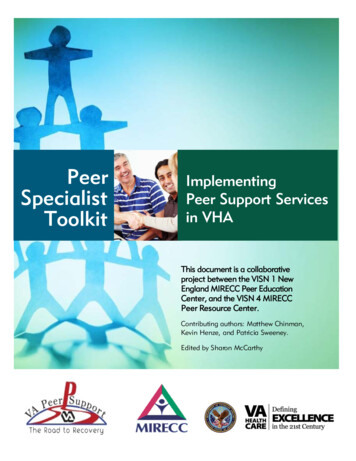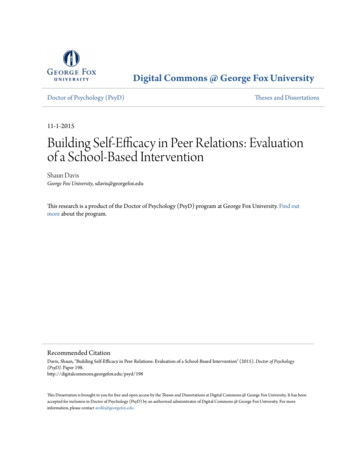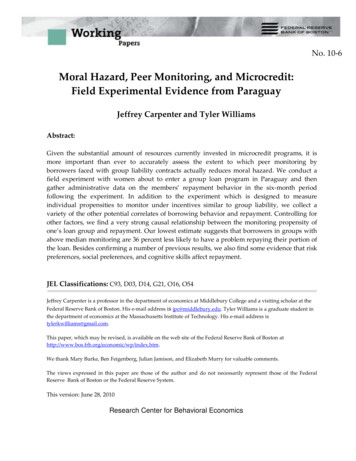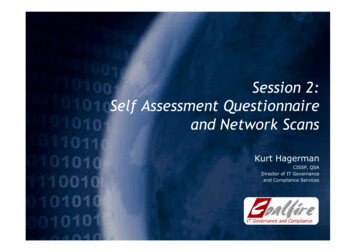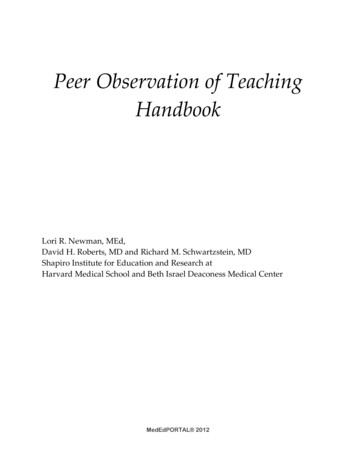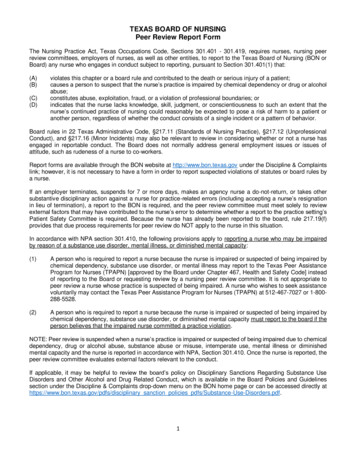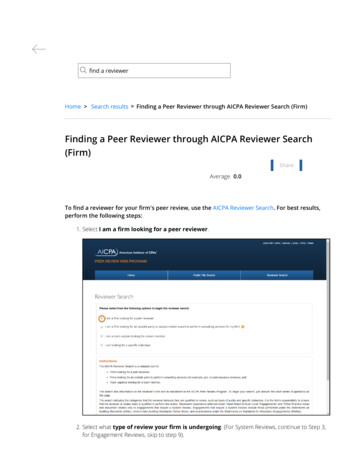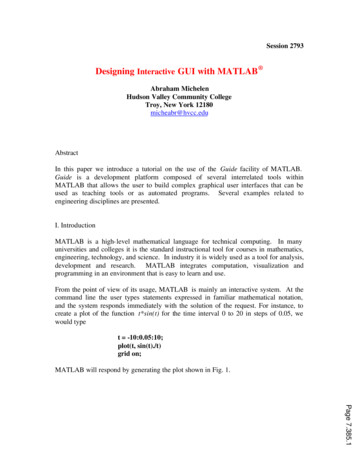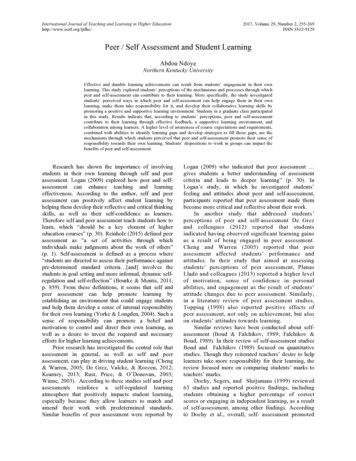
Transcription
International Journal of Teaching and Learning in Higher Educationhttp://www.isetl.org/ijtlhe/2017, Volume 29, Number 2, 255-269ISSN 1812-9129Peer / Self Assessment and Student LearningAbdou NdoyeNorthern Kentucky UniversityEffective and durable learning achievements can result from students’ engagement in their ownlearning. This study explored students’ perceptions of the mechanisms and processes through whichpeer and self-assessment can contribute to their learning. More specifically, the study investigatedstudents’ perceived ways in which peer and self-assessment can help engage them in their ownlearning, make them take responsibility for it, and develop their collaborative learning skills bypromoting a positive and supportive learning environment. Students in a graduate class participatedin this study. Results indicate that, according to students’ perceptions, peer and self-assessmentcontribute to their learning through effective feedback, a supportive learning environment, andcollaboration among learners. A higher level of awareness of course expectations and requirements,combined with abilities to identify learning gaps and develop strategies to fill those gaps, are themechanisms through which students perceived that peer and self-assessment promote their sense ofresponsibility towards their own learning. Students’ dispositions to work in groups can impact thebenefits of peer and self-assessment.Research has shown the importance of involvingstudents in their own learning through self and peerassessment. Logan (2009) explored how peer and selfassessment can enhance teaching and learningeffectiveness. According to the author, self and peerassessment can positively affect student learning byhelping them develop their reflective and critical thinkingskills, as well as their self-confidence as learners.Therefore self and peer assessment teach students how tolearn, which “should be a key element of highereducation courses” (p. 30). Reinholz (2015) defined peerassessment as “a set of activities through whichindividuals make judgments about the work of others”(p. 1). Self-assessment is defined as a process where“students are directed to assess their performance againstpre-determined standard criteria [and] involves thestudents in goal setting and more informal, dynamic selfregulation and self-reflection” (Bourke & Mentis, 2011,p. 859). From these definitions, it seems that self andpeer assessment can help promote learning byestablishing an environment that could engage studentsand help them develop a sense of internal responsibilityfor their own learning (Yorke & Longden, 2004). Such asense of responsibility can promote a belief andmotivation to control and direct their own learning, aswell as a desire to invest the required and necessaryefforts for higher learning achievements.Prior research has investigated the central role thatassessment in general, as well as self and peerassessment, can play in driving student learning (Cheng& Warren, 2005; De Grez, Valcke, & Roozen, 2012;Kearney, 2013; Rust, Price, & O’Donovan, 2003;Winne, 2003). According to these studies self and peerassessments reinforce a self-regulated learningatmosphere that positively impacts student learning,especially because they allow learners to match andamend their work with predetermined standards.Similar benefits of peer assessment were reported byLogan (2009) who indicated that peer assessment gives students a better understanding of assessmentcriteria and leads to deeper learning” (p. 30). InLogan’s study, in which he investigated students’feeling and attitudes about peer and self-assessment,participants reported that peer assessment made thembecome more critical and reflective about their work.In another study that addressed students’perceptions of peer and self-assessment De Grezand colleagues (2012) reported that studentsindicated having observed significant learning gainsas a result of being engaged in peer assessment.Cheng and Warren (2005) reported that peerassessment affected students’ performance andattitudes. In their study that aimed at assessingstudents’ perceptions of peer assessment, PlanasLladó and colleagues (2013) reported a higher levelof motivation, sense of confidence in personalabilities, and engagement as the result of students’attitude changes due to peer assessment. Similarly,in a literature review of peer assessment studies,Topping (1998) also reported positive effects ofpeer assessment, not only on achievement, but alsoon students’ attitudes towards learning.Similar reviews have been conducted about selfassessment (Boud & Falchikov, 1989; Falchikov &Boud, 1989). In their review of self-assessment studiesBoud and Falchikov (1989) focused on quantitativestudies. Though they reiterated teachers’ desire to helplearners take more responsibility for their learning, thereview focused more on comparing students’ marks toteachers’ marks.Dochy, Segers, and Sluijsmans (1999) reviewed63 studies and reported positive findings, includingstudents obtaining a higher percentage of correctscores or engaging in independent learning, as a resultof self-assessment, among other findings. Accordingto Dochy et al., overall, self- assessment promoted
bility for one 's learning.Bourke and Mentis (2011 took a differentperspective and investigated the benefits of selfassessment with respect to inclusion. The authorsreported that self-assessment can not only fosterstudents’ involvement in their learning, but it can alsoprovide appropriate learning opportunities to allstudents through “inclusion in choices about their ownlearning” (p. 854). This is consistent with whatTopping (2003) reported when he indicated that “ inself-assessment, the intention is to engage the learnersas active participants in their own learning .In thelonger term , it might impact self-management oflearning and tuning of learning by the learner ratherthan waiting for others to intervene” (p. 58).Given the importance of feedback and thedevelopment of the reflective skills, the benefits of selfand peer assessment may be more sustained when theyare implemented as formative types of assessment.Research (Struyven, Dochy, & Janssens, 2002) hasindicated that students’ anxiety and stress might hinderdeep learning when peer and self-assessment are usedas summative tasks or to assign a grade. When self andpeer assessment are used in a formative manner, theyprovide the necessary conditions to engage students intheir own learning. Students who are actively engagedin their learning through formative assessment tasks aremore likely to become aware of learning gaps and theneed to find and use more resources to address thesegaps. In other words, “formative assessment is vital forlearning and that the type of formative assessment thatcontributes to students’ development as effectivelearners is that which includes elements of self and peerassessment” (Logan, 2009, p. 30). Providing studentswith a chance to engage in formative peer and selfassessment activities make them actively involved intheir learning and may positively impact theirperceptions of the integration and relevance amongcontent taught, learning expectations and assessment(Struyven et al., 2002; Vu & Dall’Alba, 2007).While the literature might be populated withmultiple studies that investigated the benefits of self andpeer assessment, few or very little of them focused onstudents perceptions of how self and peer assessmenthelp them learn. Even though few studies (i.e. Logan,2009) reported learning gains from a student perspective,their focus was not to investigate students’ perceptions ofthe mechanisms that facilitated those learning gains.Most of the studies reviewed above tend to focusmore on comparing students’ assigned grades withthose of a teacher or tutor by attempting to investigatethe relationship between self and peer assessment andlearning gains. For example, in his review of theliterature on peer assessment, Topping (1998) reportedthat most of the studies reviewed involved marking orAssessment and Student Learning256grading peers’ work and aimed at either “saving staffassessment time or costs while other projects aimed toadd value in terms of cognitive, metacognitive or othergains for participants” (p. 251). Furthermore, Toppingemphasized the prevalence of anonymous peerassessment and that personal contact between assessorand assessee was not necessary. Given the crucial roleof self and peer assessment on student learning gains asevidenced in the literature, it is very important tounderstand the ways in which students think peer andself-assessment help them learn. It is to fill such a gapthat the current study intends to explore students’perceptions of the ways and means through which selfand peer assessment can help support and enhance theirlearning. More specifically this study addresses thefollowing questions: Through which mechanisms, do studentsperceive that peer and self-assessmentcontribute to their learning?In what ways, do students perceive self andpeer assessment as practices that can promotetheir sense of responsibility towards their ownlearning?MethodsThis explorative study was exempted by theInstitutional Review Board and took place in a graduateclass. The study utilized qualitative methods to analyzestudents’ perceptions of the benefits of self and peerassessment as well as the factors through which thosebenefits occur. An online survey was used to collect data.ParticipantsParticipants were 31 students enrolled in a graduatecourse in a Social Science based area studies programin both Fall 2013 and 2014 semesters. Instruction in thiscourse landed itself to peer and self-assessmentactivities as it involves some lecturing and seminar typework such as hands-on activities and group work. InFall 2013 there were 12 students with 9 of them beingfemale students. In the Fall 2014 semester, there were19 students, and 15 of them were female students. Thispredominance of female students is consistent with thegeneral trend in the university. Sixteen (51.6%) of themresponded to the survey, for Fall 2013 (9 out of 12students) and Fall 2014 (7 out of 19 students). This wasa required course. Half of the respondents (8) had neverused peer and self-assessment before, while five ofthem reported having experience with both peer andself-assessment, one student with peer assessment onlyand two students with just self-assessment.The same instructor taught both Fall 2013 and Fall2014 courses. Students were informed of the intent of
Ndoyethe peer and self-assessment activities through oralcommunications during class time. They were told thatthis was part of a research project but was also aimed tohelp improve the course and their learning.ProcedureFor each semester students were briefed about selfand peer assessment processes. This briefinghighlighted the benefits of self and peer assessment inlearning, what makes peer and self-assessment effectiveand beneficial for improved learning, and the aims ofthe initiative. The different steps that they need to gothrough to implement both peer and self-assessmentwere explained in class.Assignments used for this exercise varied andincluded a literature review and an article critique. Inthe literature review assignment, students were asked toselect a topic of interest and to write a brief literaturereview using at least 5 peer-reviewed journal articles. Inthe article critique, students were asked to select aresearch article from a list provided by the instructor orto find one of their own and write a critique about thatarticle. For each these assignments, guidelines andrubrics detailing expectations and explaining gradingcriteria were also provided and explained to students.Students were then asked to use the providedguidelines and rubrics to self-assess their work. For thepeer assessment, there were two different scenarios. Inone scenario students were asked to choose their ownpartner. In another scenario, the instructor assigned apartner to each student.After completing the self-assessment students wereasked to go back and revise the work based on theirfindings from using the rubric and guidelines. Therevised work was then shared with a partner whoreviewed it using the same guidelines and rubrics. Eachstudent brought their feedback to class and shared itwith their partner. During this time students explainedtheir feedback, and this was also an opportunity forthem to ask questions or clarifications regarding theexpectations. The role of the teacher was to addressquestions raised by the students about the process ofself and peer- assessment or other general questions.Additionally, the role of teacher consisted of frequentlyarticulating and explaining the aims of the self and peeractivities to students in order to help them betterintegrate these activities in the overall learning process.Data CollectionData about students’ perceptions of how self andpeer assessment could contribute to learning andpromote a sense of responsibility for their work werecollected through an anonymous online survey that wassent to students (See appendix). This survey was sentAssessment and Student Learning257out to all students using Google Forms and via studentuniversity emails. The survey included questions aboutself and peer assessments’ contribution to students’learning and students’ responsibility for their ownlearning. In Fall 2013 semester, 9 out of 12 studentsresponded to the survey. The survey was sent out againin Fall 2014 to increase the number of respondents, and7 out 19 students responded.Data analysisStudents’ responses on the survey were analyzedand classified into themes based on their relationships.Emerging axial coding was used in this study. Asresponses were being collected, emerging themes werepresented and discussed with students in class forvalidation purposes. Additionally, thick description wasalso used in attempts to ensure validity.ResultsSixte
helping them develop their reflective and critical thinking skills, as well as their self-confidence as learners. Therefore self and peer assessment teach students how to learn, which “should be a key element of higher education courses” (p. 30). Reinholz (2015) defined peer assessment as “a set of activities through which individuals make judgments about the work of others” (p. 1 .
